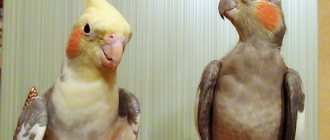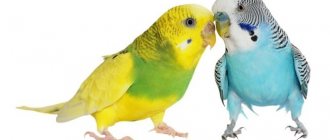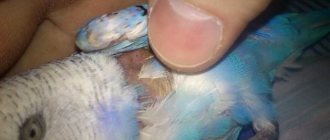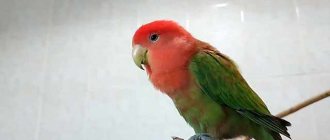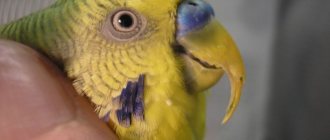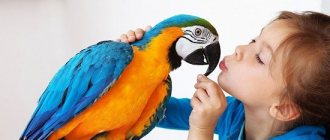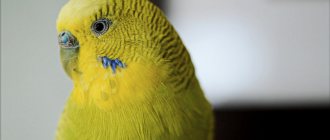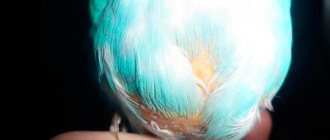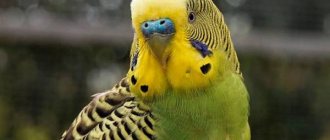Many diseases of budgies lead to disastrous results - the birds die. Most problems can be prevented if you keep your pets properly and monitor their condition. In order not to get confused at a crucial moment, it is worth studying the main symptoms of diseases in advance. Let's find out what causes budgies to get sick, and get acquainted with methods of treatment and prevention.
Digestive system diseases
Future and current owners should know what diseases budgerigars have and their symptoms. Diseases of the gastrointestinal tract are not uncommon for birds. They have different causes, symptoms and treatment methods.
The most common gastrointestinal diseases in budgies:
- Digestive disorders are often caused by the absence of sand stones in the stomach (where they grind food), stress, colds, eating unripe grapes, excessive consumption of greens and fruits, or the same type of diet. Then problems with defecation arise: loose stools, undigested grain in the droppings, diarrhea, constipation, pecking of the cloaca (the end of the rectum) and intestinal blockage with feces. The basis of treatment is diet; parrots can also be prescribed medications.
- Intoxication can be caused by poor-quality or spoiled food, poisonous plants (nightshade, broom, cherry grains, plums and yew needles) and grains that are treated with herbicides and other chemicals. The bird can be poisoned by a piece of herring, preservatives, sodium pyrosulfate, poisonous gases, paint, medications or insecticides. Intoxication is manifested by restlessness, loss of appetite, diarrhea (sometimes bloody) and vomiting. The budgie needs to be given an absorbent and a veterinarian should be called.
- Vomiting and regurgitation are a sign of many dangerous diseases: bacterial, fungal, viral and parasitic. This symptom may appear against the background of diseases of the heart, liver, pancreas, kidneys, gastrointestinal pathologies, diabetes mellitus, intoxication and mental disorders. Treatment depends on the causes.
- Esophagitis is inflammation of the esophagus. Causes of the disease: trauma to the mucous membrane by foreign objects, bacterial inflammation and damage to the walls by hot food. The budgerigar is depressed, eats little, is exhausted and is breathing heavily.
- Intestinal diseases. Enteritis is manifested by intestinal blockage. With gastroenteritis, the stomach and small intestine are inflamed. Cloacitis is characterized by inflammation of the cloaca and impaired intestinal function. With duodenitis, the duodenal mucosa is inflamed. Dysbacteriosis is manifested by a violation of the sanitary conditions of keeping birds.
- Stomach diseases. With gastritis, the gastric mucosa becomes inflamed. Cuticulitis is characterized by severe inflammation and necrosis of the mucous membrane of the glandular layer.
Also, budgies are characterized by gastrointestinal diseases such as fatty liver, hepatitis, tumors and liver rupture.
Owners often wonder why their budgerigar eats a lot. Excessive appetite can be caused by stress. Sometimes birds refuse food due to anxiety or, conversely, eat a lot. In this case, it is important to eliminate the cause of stress so that everything returns to normal.
Diarrhea
Diarrhea is not a separate disease, but a symptom of a specific illness. The causes of diarrhea in budgies are:
- Diseases of the digestive tract. Birds have a sensitive gastrointestinal tract, so stale or poor-quality food causes upset.
- Infections. A budgerigar can become infected from other animals or suffer due to poor living conditions.
- Stress comes from moving, having a new neighbor, or being scared.
- Long course of antibiotics.
- Inflammatory damage to the goiter (sac-like expansion of the esophagus) is caused by poor-quality food.
- Keeping the cage in a draft.
Interesting! Sometimes owners confuse diarrhea with polyuria in budgies (excessive urination). Then the droppings are normal and the feces are diluted due to an increase in the volume of urine. When the liquid dries, it becomes noticeable that the consistency of the stool is normal.
It is worth contacting a veterinarian if your budgie suffers from diarrhea, vomiting and refuses to feed, its feathers are tousled, and near the cloaca they are dirty and stuck together.
You can try to determine the disease by the type of litter:
- the presence of whole grains – infections, goiter inflammation and mycosis;
- green or yellowish-green feces – liver disease, intoxication and parasitic disease;
- liquid stool, no white matter - dysfunction of the nervous system;
- a lot of white matter in the litter – kidney failure or arthritis;
- black color and a lot of liquid – diseases of the stomach or nervous system;
- whitish-gray stool – pancreatitis, too much fat in the diet.
If the droppings are red, you should immediately contact a veterinarian. The specialist will order tests to diagnose the illness that is causing the diarrhea.
The basis of treatment for budgies with diarrhea is diet. First of all, you need to change the food, remove vegetables, fruits and herbs. This way the owner will eliminate the source of toxins. But you cannot deprive the bird of food, as its body needs nutrients. It is necessary to provide the bird with a variety of food. If he is forced to starve, he will not be able to regain his strength.
The basis of the diet can be millet and oats. You can cook rice porridge for your budgie in water without salt. It is also important to change the water frequently.
To combat diarrhea, adsorbents, vitamins and probiotics are used, which will help restore the intestinal microflora. A decoction of chamomile and St. John's wort has an antimicrobial effect.
For infectious diseases, birds are prescribed immunomodulatory drugs, for example, Gamavit. Antibiotics are indicated for bacterial infections.
Important! A doctor's help is needed even if the diarrhea lasted several hours and then disappeared. Many infectious diseases in budgies quickly become chronic. Then the bird may suddenly die during the next exacerbation.
How to give medicine to a parrot
The medicine is mixed into the food. It is best if the veterinarian determines the daily dose individually. It depends on the age, type, size and disease of the bird. It is important to know that if you decide to treat a bird yourself, and the bird refuses to eat food and water, then the medicine must be forcibly administered through a syringe (without a needle).
The solution is poured through the corner of the beak very slowly so that the bird does not choke. The veterinarian usually uses a probe or intramuscular injection to administer the medication orally.
Video: how to give medicine to a parrot's beak
Regurgitation of food and vomiting
Vomiting is a reflexive eruption of stomach contents. This is an important mechanism that protects against toxins. Many owners call vomiting a condition in which a bird regurgitates grains. In budgerigars it occurs against the background of a specific disease or is a reaction to external stimuli. Birds can also do this to feed another parrot, a person, or any object (toys or mirrors). The first condition is a variant of the norm, the rest are mental disorders.
When a mentally disturbed parrot spits out grains, it can become poisoned. After all, vomit dries up in the air and goes out over time. The bird may then put it back into its mouth, resulting in bacterial and fungal toxins.
Vomiting is a symptom of intoxication. Possible causes of poisoning: food, bacteria, fungi, viruses and metabolic products due to impaired liver or kidney function.
Some diseases of budgerigars lead to compression of the esophagus or crop, which causes vomiting. These include:
- functional heart failure (chronic form);
- a sharp increase in blood pressure;
- formation of granulomas or tumors in the mediastinum;
- inflammation of the goiter due to infection with worms, protozoan microorganisms (trichomoniasis) and fungi of the genus Candida or bacteria.
Vomiting in birds sometimes occurs due to abdominal pain. This is possible if the budgerigar gets sick with enteritis, vitelline peritonitis, inflammation of the fallopian tubes or air sacs. A stuck egg in a female can also cause vomiting.
The cause of regurgitation of semi-digested food can be a bornavirus infection; the disease is also accompanied by sudden weight loss and the appearance of whole grains in the stool. At the same time, the birds' appetite is normal. Radiography, PCR and biopsy will help identify pathology.
Vomiting in budgies can occur due to poor conditions:
- temperature below or above 25°;
- drafts;
- the cage is located next to heating devices;
- sudden change in diet;
- high protein content;
- overdose or deficiency of vitamins and minerals.
Budgerigars can regurgitate food if they are allergic to poor-quality food or product and as a result of overfeeding.
Mites on parrots
Perhaps this is one of the most common misfortunes among birds. Ticks pose no danger to humans. A sick bird itches almost constantly. If you pull apart the plumage and look closely, you can see the ticks themselves. They can also appear on the paws, near the eyes or beak.
If ticks are not dealt with, growths may form on the paws or beak. Vaseline or vegetable oil will help fight these pests, which will block access to oxygen and prevent the parasites from breathing, as a result of which they will die. You can also use aversectin or novertine ointment.
Video: parrot mites
Pushing food
Pushing food is a pathology in which a budgerigar, after swallowing food, stretches its neck forward and makes yawning movements. It opens its beak wide and extends its tongue. These symptoms indicate that budgies are sick.
In this way, birds try to make it easier to push food into the pharynx at the base of the skull. Immediately after these movements, the bird begins to scratch its nostrils, which indicates problems in this area.
A bird can push food through any disease that is accompanied by compression of the esophagus in the chest area or compression of the crop by air sacs in the neck area.
With a passive lifestyle, budgies develop heart failure. This leads to an increase in the volume of the atria and compression of the esophagus by the heart.
“Yawning” also occurs with spondylitis (destruction of the vertebrae) of the cervical spine. The disease causes pain in the neck, then the bird, after swallowing food, stretches its neck, opens its beak and stretches out its tongue.
Why is your pet sick?
First, let's determine what affects the health of a parrot. Conventionally, all influencing factors can be divided into 4 categories.
The main causes of parrot disease
- Proper nutrition. Food for wavy birds must correspond to the food supply that birds have in their homeland in Australia. We are talking about grain crops, vegetables, fruits. Constantly feeding food from your table is unacceptable. An excess of salts, fats, and sugar has a detrimental effect on the body of parrots. The diet must contain vitamins.
- Proper care. Hygiene is no less important for birds than for their owners. Cleanliness in the cage, inspection and handling of things brought from unfamiliar places. If there are other animals in the house that have access to the street, then their contact with the bird must be excluded. These measures are necessary to exclude infectious diseases.
- Correct handling. Budgerigars are flocking birds. Communication is extremely important to them. Therefore, it is important to create a comfortable environment for your pet. The lack of conversation, interesting activities, and toys leads to a stressful situation for the wavy. And health problems will not take long to appear.
- Correct genetics. Close relationships negatively affect a pet's health, making it vulnerable to many diseases. If the problem was not identified at the time of purchase, then it is difficult for the parrot’s owner to influence this factor; they can only make the pet’s life a little easier.
Parrot diseases
Respiratory system diseases
Fans of budgies need to know what diseases they can suffer from. The list of characteristic ailments is supplemented by pathologies of the respiratory system.
Important! Budgerigars do not get colds, so if symptoms of respiratory diseases appear, you should consult a veterinarian. They are caused by serious problems that require professional help.
Diseases occur as a result of hypothermia of the wavy. This is possible if the cage is in a damp and cold room or in a draft.
In diseases of the respiratory organs, the larynx, nasal passages and large bronchi may become inflamed.
Signs of respiratory disease in budgies:
- the parrot does not chirp, he is depressed;
- rapid breathing is heard and whistling or wheezing is present;
- the beak is slightly open;
- decreased appetite;
- clear mucus oozes from the nose (due to inflammation of the nasal passages).
In some cases, you can cure a budgie at home. But it is recommended to consult a veterinarian first.
Sinusitis
Above the eyes, as well as in the area between the corner of the eye and the nostrils, there are air sinuses - sinuses. They are connected to the air sacs in the neck, and they communicate with the nasal cavity through formations that resemble small caves. The sinuses are covered on top with a thin layer of skin.
When an infection penetrates the paranasal sinuses, this leads to the development of inflammation and the accumulation of mucous and purulent fluid. You can tell that your budgerigar has sinusitis by the following symptoms:
- swelling of the area around the eyes;
- redness of the affected area;
- the appearance of bags under the eyes.
In budgerigars and other small parrots, inflammation of the sinus cavities is often caused by chlamydia and mycoplasma. In large parrots, the disease is provoked by Eschirichia, Klebsiella and Aspergillus.
Treatment of this disease in budgies is aimed at eliminating its root cause. If too much mucus or pus has accumulated in the sinuses, then antibiotics are injected into their cavity. Anti-inflammatory therapy is used.
Rhinitis
The causes of a runny nose in a bird are as follows:
- keeping at low temperature or in a draft;
- irritation of the nasal passages by foreign objects, such as dust particles;
- damage to the mucous membrane by gaseous substances (ammonia or formaldehyde).
Often a runny nose occurs against the background of diseases of bacterial origin. Then the nasal passages are affected by streptococci, staphylococci and hemophilus influenzae.
Ornithosis or psittacosis is also accompanied by rhinitis. This is a bacterial disease, the symptoms of which include damage to the respiratory system. Psittacosis in budgies is caused by chlamydia. The pathogen is released into the environment through nasal secretions and droppings.
Important! The danger of psittacosis is that you can get infected from a budgie. The disease is manifested by a dry cough, stabbing pain in the chest, discharge of mucopurulent sputum (sometimes with blood), intoxication and fever.
Rhinitis in birds is often observed with pseudoplague or aspirgellosis.
A sick budgie sneezes, serous secretions leak from the nasal passages, and the area between the eyes and nostrils may become swollen. Against the background of rhinitis, the parrot is breathing heavily, you can hear wheezing or whistling. These symptoms lead to apathy, shortness of breath and exhaustion.
A sick budgie needs prompt diagnosis and treatment. Otherwise, complications are possible: bronchitis, sinusitis and pneumonia. These infections can lead to death.
Voice change
An alarming symptom for a budgie is a change in voice. It indicates diseases of the respiratory organs. Therefore, you need to listen carefully to the chirping of your feathered pet. If your budgerigar is breathing frequently, his voice is hoarse, roughened or the tone has changed, then this is a good reason to visit the veterinarian. It is also worth doing if the previously constantly singing parrot is silent.
Chronic inflammation of the air sacs is manifested by clicking sounds during breathing. There are no other signs of the disease. These sounds are similar to the sound of a sheet of paper being folded in half. This is an alarming symptom that indicates the presence of dangerous respiratory infections.
Dangerous diseases of budgies, which are accompanied by pain and spasm of the abdominal respiratory muscles, are manifested by the sound “hic”. Often this symptom occurs in females with difficulty laying eggs. After this symptom appears, the bird owner has several hours to save its life. You can't do it without the help of a professional.
Caring for a sick bird
A sick budgie sits away from other individuals in a quiet place. White paper sheets are placed at the bottom of the cage to constantly monitor the status of feces.
If a budgie gets sick, it should be fed peeled oats or millet. Greens and cereals are excluded for a while. A budgie that is being treated at home can drink weak tea or chamomile decoction.
The heating lamp should be positioned in such a way that the pet can, if desired, move closer to the warmth or, conversely, hide in a shaded area.
If treatment measures are taken in a timely manner, the bird recovers within 3–4 days. After recovery, it is washed under warm water and wiped dry. The cage also needs to be washed and disinfected.
Feather and paw diseases
Normally, a budgerigar's feathers should be smooth, bright and shiny. Problems with plumage indicate various diseases (with the exception of molting).
Dark spots are a sign of destruction of the feather structure and pigment. Similar changes occur in cases of protein metabolism disorders, liver or kidney diseases, and various infections.
Black, brown spots or stripes along the edges of the feathers indicate the long-term development of pathology. The cover darkens 5–6 days after the functionality of the internal organs is impaired.
There are diseases of budgies that lead to loss or damage of feathers:
- Feather pecking occurs due to infections, stress, dietary deficiency and boredom. Treatment involves removing damaged feathers, stopping bleeding, taking baths with chlorhexidine and improving living conditions.
- Superficial mycoses - damage to the upper layers of the skin and plumage by dermatophytes.
- Bacterial granulomas are rough growths that cause feather loss in budgies.
- Purulent inflammation of the skin is manifested by dryness and wrinkling in the damaged areas. In budgerigars, the chest is more often affected.
- Circovirus is a severe viral disease that suppresses the immune system and affects the plumage, beak and claws. The feather shafts break and the bulbs die. This is accompanied by diarrhea. If a budgie gets sick, it is prescribed avian interferon.
Interesting! Circovirus is incurable and an infected bird will live for about 2 years.
Brown or black spots may indicate rickets and chronic diseases of the chicks. And transverse stress lines indicate protein deficiency in the blood and reflex vasospasm.
Budgerigars often have paw diseases:
- arthritis;
- bruise or dislocation;
- namins (calluses on the soles);
- fracture;
- erosive and ulcerative lesions of the paw pads;
- gout of the joints.
These diseases are accompanied by pain, limited mobility, lameness and loss of supporting function of the limb (in case of a fracture). They can be caused by improper maintenance, poor diet and injury.
If cracks, calluses, thickening or thinning areas appear on your budgerigar's feet, he should be seen by a veterinarian. These symptoms may indicate kidney disease, liver disease, spine disease, innervation disorders, infections (viral or fungal) and vitamin A deficiency. It is important to conduct a full examination to identify the cause of paw pathology.
Treatment is usually medicinal, rarely surgical. It is also necessary to improve the living conditions, for example, buy a larger cage and select suitable perches.
Signs of a Healthy Bird
The health of a parrot directly depends on its owner. If the food is correct and the cage is clean, then diseases of wavy pets are usually suppressed by strong immunity.
The main differences between a healthy bird and a sick bird include:
- bright and clean feathers;
- expressive look;
- clean beak;
- smooth scales on paws;
- interest in others;
- the pet sleeps on one leg.
If the bird fully matches the description, then it is completely healthy.
Eye diseases
Poultry farmers should know what diseases budgies can suffer from. They often suffer from the following eye pathologies:
- Conjunctivitis (bacterial, fungal or viral) is an inflammatory lesion of the eyelids. The disease is manifested by redness, swelling and sometimes discharge. For treatment, disinfectant solutions, eye drops and ointments are used. You should not hesitate to go to the veterinarian, as the infection can become chronic.
- Cataract is a clouding of the lens of the eye, then the pupil becomes whitish. The disease occurs when the nutrition of the lens, innervation, and blood supply to the eye are disrupted. It can develop against the background of osteochondrosis or osteomyelitis of the cervical segment of the spine, as well as infections that affect the bone marrow or air sacs.
- Ulcerative keratitis is a disease of the budgerigar in which the epithelial layer is disrupted, which affects the stroma. The disease develops against the background of bacterial infections of the eye. Ulcerative keratitis develops together with conjunctivitis. If not treated promptly, the infection penetrates into the eye, which can lead to eye loss.
- Cystosis is manifested by swelling of the lower eyelids. Treatment is carried out in a veterinary clinic, where the doctor opens the tumor and cleanses the wound.
The most severe eye disease of the budgerigar is panophthalmitis. The pathology is manifested by purulent inflammation of all media and membranes of the eye. Only an experienced veterinarian can treat birds using broad-spectrum antibiotics, anesthetic and disinfectant solutions.
Beak diseases
The following beak diseases occur in budgies:
- Deformation. Congenital deformation of the beak is caused by a violation of rearing technology. The causes of the acquired form are sinusitis, rickets, scabies, injuries, metabolic disorders and diseases of the endocrine glands.
- Excessive beak growth is observed in the presence of soft food in the diet, liver diseases, metabolic disorders and deficiency of nutrients (vitamin A, C and calcium).
- Inflammation of the beak due to a severe lack of vitamin A, damage to its cavity and injuries.
- Tumors that gradually destroy the beak.
Hyperkeratosis is often found in budgies. This is a skin growth, which is also called a cere. It may be naked or covered with feathers. The strip of skin over the beak becomes rough and enlarges due to vitamin A deficiency. Treatment consists of supplementing the diet with foods that are rich in carotenoids.
Heart diseases
Physical inactivity (lack of movement) in budgerigars leads to functional heart failure. The disease is manifested by passivity, reluctance to fly and pushing through food. If such symptoms appear, you need to visit a veterinarian who will prescribe an x-ray and electrocardiography.
In case of heart failure, complex therapy is carried out. It consists of adjusting the diet, taking specific medications (including for the treatment of chronic infections) and physical activity. Usually the disease is detected in late stages, so treatment takes a long time.
Budgerigars are often diagnosed with hypertension. Blood pressure increases due to improper feeding and care of the bird. Pathology leads to dysfunction of the kidneys and liver. Therapy should be comprehensive: proper nutrition, improvement of living conditions, taking antihypertensive drugs and normalization of liver and kidney functions.
Infectious diseases
The following infections are common in budgies:
- Mycoplasmosis is accompanied by decreased appetite, lightening of the beak, passivity and damage to the respiratory organs (cough and heavy breathing).
- Myxomatosis is manifested by coughing, sneezing, soiled feathers, body shaking, refusal to eat, weight loss, and discharge from the eyes and nostrils.
- Psittacosis. It has the following symptoms: deterioration of feathers, loss of appetite, discharge from the nasal passages, diarrhea and fever.
- With salmonellosis, the joints of the paws become inflamed and swollen, and fever occurs. The budgie sits motionless, its feathers ruffled, and it refuses to eat.
- Candidiasis is manifested by thickening of the goiter walls, frequent yawning, weakness and severe diarrhea.
- Giardiasis in the later stages leads to death due to intoxication.
- Infectious kidney diseases are accompanied by weakness, apathy, swelling of the abdomen, numbness of the legs and wings and sudden weight loss.
- Viral infections are characterized by heavy breathing, coughing and sneezing.
Important! It is worth remembering that with infectious diseases the pet is contagious. Therefore, you should avoid contact with him.
Poisoning in parrots
In case of poisoning and dehydration (usually characterized by diarrhea, vomiting), a 5% glucose solution is used: for small parrots - 0.2-0.4 ml per beak 1-3 times a day for a week, for medium parrots - 1-2 ml 2 -3 times a day for a week, for large parrots and birds - 4-15 ml 2-3 times a day for a week.
It is best to discuss the exact dosage with your veterinarian; when treating yourself, remember the main rule - do no harm!
The cause of poisoning can be anything: from table salt to household chemicals.
Whatever the cause of the poisoning, if you observe diarrhea, cramps and severe thirst in your bird, then you should give your pet an absorbent as soon as possible, which will help reduce the level of toxins in the body. It can be activated carbon, enterosgel, smecta
.
It is also recommended to heat the bird with a lamp (table lamp, for example) and add a few drops of citrus juice to the drinker.
Parasitic diseases
Budgerigars can suffer from endo- (internal) and ectoparasites (external). The first include helminths that feed on blood, tissue juices and nutrients from the intestines. External parasites include fleas, ticks, feather eaters and flies. They feed on the bird's body and are located on its surface.
Most often, budgies are affected by Giardia (protozoan endoparasites). The disease causes lethargy and diarrhea. The bird also plucks feathers to distract itself from pain in the intestines, right hypochondrium and glandular stomach. The owner can become infected from the pet. Precautionary measures will help avoid this, including treating the bird’s cage and accessories with disinfectants.
Budgerigars often suffer from coccidiosis and hexamitosis; their pathogens are also protozoa. These diseases have a hidden course. The parasite can only be identified after laboratory testing of feces. These pathologies are not dangerous for people and other pets.
Ectoparasites
The following mites can live on the surface of a budgerigar's skin:
- Ixodidae. They resemble grayish warts (about 1.5 cm). They are carried by rodents and also live on tree branches. They drink the bird's blood. If the infection is severe, the bird may die from exhaustion. It can infect people and other pets. The parrot is quarantined and treated with antiparasitic agents.
- Gamazovye. These pincers (less than 1 mm) are red in color and move quickly. During the day they hide from light in the cracks of the room, and at night they attack birds. Arthropods drink blood and lymph. The fight against them involves regular cleaning and treating the cage with insecticides.
- Scabies. This type of tick causes a dangerous disease - knemidocoptic mange. Parasites gnaw passages in the epidermis and live in the upper layers. They receive nutrients from tissue fluid. They can only be seen under a microscope. The disease is manifested by itching, as well as a skin rash in the form of tubercles or blisters. Insecticides (sprays, ointments and injections) are used for treatment. Therapy lasts from 7 to 30 days.
- Feather mites are rarely diagnosed. The parasite infects the feather shaft, leading to its destruction and loss. In later stages, the disease causes bald parrots to go bald.
Birds can develop down-eaters - wingless insects that resemble dark dots about 8 mm in size. They are placed near the lower end of the feather shaft, in which they chew holes. To get rid of them, insecticides are applied to the parrot's skin.
When kept in an aviary, budgies can be infected with bloodsucker flies. They are fast and small (up to 1 cm) and can be noticed upon inspection. They can be carriers of infectious diseases. Treatment consists of a single treatment with insecticides.
Fleas can live in the feathers of a budgerigar. They bite, cause itching and lay eggs. Insecticides are used to eliminate them. You can treat your parrot at home after consulting a veterinarian.
Danger to humans
Most of these diseases do not pose significant dangers to humans. The exception is salmonellosis. If this diagnosis is detected in a pet, it is necessary to urgently sanitize the room where the bird is located, disinfect the cage, and places where the parrot could sit.
Prohibit children and other family members from contacting the patient. Salmonellosis can also be transmitted through other pets, so it is worth maintaining an increased level of hygiene. Particular attention should be paid to this in families with children under 2 years of age.
Common diseases of parrots?! Roundworms, what are they?!/ My miracle in feathers
